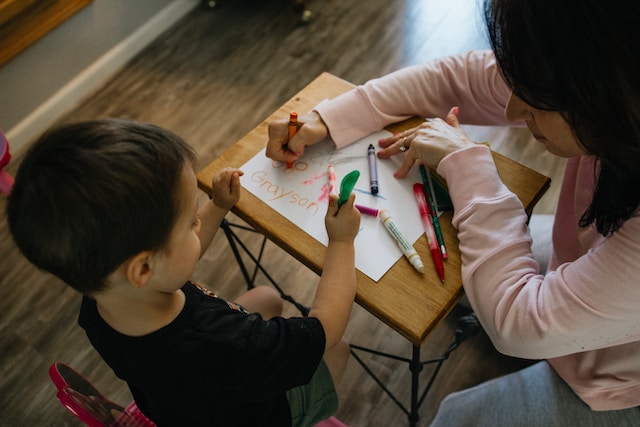6 tips to help toddlers and preschoolers with powerful feelings and emotions

Big, powerful emotions are inevitable as young children grow into thinking, feeling little people. When the world feels volatile, toddlers and preschoolers need emotionally reassuring grown-ups to help them to understand what they feel, to feel safe and to find a positive way through the emotional storm.
Managing age-appropriate problems and the contradictions of everyday life is essential to social-emotional growth. Yet, the preschool years are filled with every day dramas and challenges guaranteed to set off emotional storms for kids and for the grown-ups who love them.
Remember the push-n-pull of knowing what you want and how you think the world should be:
• Wanting to wear your favorite shirt for 30 days in a row
• Trying to master the same puzzle as an older child and nothing fits in place
• Asking for your sandwich cut into four pieces and then not able to make it whole again
• Being excited that your friends are coming to play but then realizing they won’t play the game you wanted to play
• Loving your parents so much it’s scary to say good night
Moments of anger, confusion, sadness, uncertainty, fear and frustration are part of everyday life. Some moments pass easily while others will have your child stuck for the rest of the day. Every situation is an opportunity to feel and think, learn and grow.
Here are 6 strategies to help toddlers and preschoolers become masters of their own feelings and capable problem solvers.
1. Begin with establishing emotional calm. Young children have extreme difficulty thinking and feeling at the same time. Grown-ups must show the way by engaging without over-reacting. Get close. Get quiet. And most of all, try not to pile your emotions on top of your child’s emotions. It’s always okay to ask for a few minutes for everyone to get calm before trying to help. Simply say something like, “whoa, looks like things are getting crazy. Let’s take a minute so we can figure out what to do (what you need, if you want help, etc.)”
2. Stop the action by describing the situation. When emotions escalate, toddlers and preschoolers get blinded by the emotional struggle and can no longer see the problem at hand. It’s great to label emotions (e.g. I see your angry, frustrated, upset, etc) but it’s essential to connect the feeling to the provocation. Find the description (e.g. “I know you aren’t ready to leave the park” or “You want to wear your blue shoes and can’t find them”) that gives your child the opportunity to say “YES!” – yes, that’s what I want, what I think, what I feel. Creating the “yes moment” helps your child feel seen, heard and understood.
3. Take notice of your child’s feelings. Is your child frustrated because he’s not finished with his turn? Is your child worried about an upcoming move or excited about her birthday party? Every experience has an emotional connection. Your child needs to know all feelings are okay, including anger, jealousy, impatience, confusion, panic, vulnerability and lack of control. Empathy makes feelings less scary and more “normal”. Comfort and care, help and problem solving can only happen after feelings are acknowledged.
4. Incorporate a feelings vocabulary into your daily routine. Storytelling, pretend play or casual conversations in the car or at the end of the day give your child experience and practice when it’s not all personal. They also have the chance to revisit troublesome feelings or frustrating reality when it’s less urgent and they are less fragile. Validate unsettling feelings in neutral settings with characters like No David and Angry Sophie. Reassure with No Matter What. See this great starter book list from ZerotoThree.org.
5. Be an ally through the emotional storm. Children need adults to guide them through complicated emotions – neither dismissing nor avoiding. Frustration, anger and impatience need to be acknowledged before your child can learn constructive expression. When parents are fearful, hurt or embarrassed by children’s emotions, they lose the ability to help the child express new, age-appropriate feelings.
6. Finally, present win-win choices. In all parent problem-solving situations, the biggest challenge is figuring out how to meet children’s needs and move the situation forward. What does your child need – time to calm down, a place to play undisturbed or someone to let him know when it is his turn? Show your child in words and action that you understand the problem and that you will help her. Be clear and decisive – it’s your presence that makes learning from the struggle possible. For example, help your child decide what she can do while waiting for what she thinks she wants now – read a book together, draw a picture of what she wants to buy at the store or put a note on the bathroom mirror to remember to wear cowboy boots tomorrow.
Not all emotional struggles can be problem solved away, not all disappointments can be fixed. All feelings can be felt and shared with loving grown-ups who are the best role-models for emotional literacy, for reassuring problem solving and for creating entitlement-free options in a Me-Mine-Now world. It is with empathy and through empathy that we teach young children to become thinking-feeling people. Emotional coaching isn’t always easy but it’s the most powerful tool you can give your child.





Follow Us
Join the conversion. Make sure to follow us on our social platforms for the latest content and FamilyTime news.